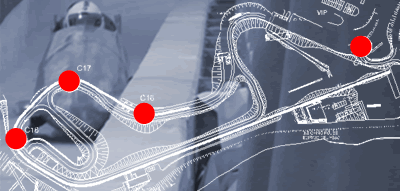Record performance on the bobsled ice track: The complete measurement chain from HBM was recently used to test the Olympic bobsled run at San Sicario near Turin. The task: to measure acceleration in the curves of the ice track.
19 curves, 114 meters in height difference, maximum speeds of up to 130 km/h. Record performance is what the San Sicario Olympic ice track demands of athletes. High standards also had to be met during measurements performed on the bobsled run. To achieve this a complete measurement chain from HBM was utilized for conducting acceleration tests in the curves of the bobsled run during the World Cup race, held at San Sicario in January 2005.
The aim of the tests was to monitor the vibration behavior of the concrete structure and to draw conclusions for optimizing the curvature of the track. For this purpose, acceleration during the runs had to be measured on several curves.
Because of the limited number of runs during the race, the test was a race against time. Thus, the use of particularly flexible and reliable test equipment was essential. The engineers from SeaTech Snc., responsible for carrying out the measurements, decided to use the flexible complete solution provided by HBM: B12 acceleration transducers together with the MGCplus amplifier system and catman software for data analysis.
Quick and reliable installation in the curves of the bobsled run
SeaTech combined three B12 acceleration transducers from HBM to obtain a triaxial sensor which was simply clamped on to free ends of the steel reinforcement in the concrete. The MGCplus amplifier was placed on the bed of a pickup truck. The SeaTech engineers simply drove to the different measuring points with the truck to acquire test data in situ, in a safe and reliable way.
Perfectly-matched, complete measuring chain from HBM
The MGCplus amplifier was connected to a notebook PC via Ethernet. All data was saved directly to the hard disk and evaluated using catman® software – a gain in data security and flexibility. A total of 7 MB of data was recorded at a sampling rate of 2,400 Hz. Thanks to the flexible trigger function provided by the MGCplus, it was possible to consider the relevant parts of the measurement, only, when making a frequency analysis in catman for visualizing the resonance state of the structure.
Successful tests
The tests with two-man and four-man bobsleds during the 23 runs of the World Cup race were successful: The concrete structure of the bobsled run exhibited only minor vibrational characteristics. Now, nothing stands in the way of the Olympic races.
